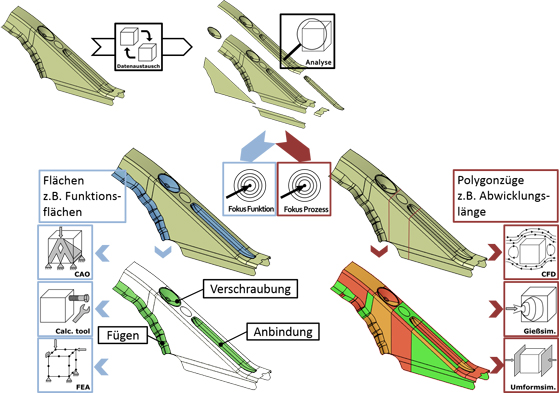Functionalized 3D CAD data in a simulation-based development process
Usage of software tools in virtual product development is characterized by heterogeneity therefore data exchange between different applications is often necessary. The parametric structure of CAD models and assignments, that have been made, will get lost during this transfer. The intention of this project is the connection of information to geometry to make it retrievable for future projects. The existing parametric models should be retained, in order to continue using them in the following development steps. The project is being implemented in the form of a neutral conceptual software demonstrator.

After breaking down the geometry in surface regions, it can be analyzed by geometrical specifications and assignments of properties, parameters and characteristics of individual surfaces are made. The required separation rules and area assignments are developed in cooperation with the project partners. To keep the investigations as universal transferable as possible, the surface functionalization is performed on three examples, each of which has different granularity:In the functional focus pieces of knowledge are linked to functional surfaces. For example, an area can be selected that is later used as the joining point. Subsequent information about the available processes or evaluation criteria for results of FE-simulations is stored.In the procedural focus two manufacturing processes are examined separately.In the forming process the manufacturability of the part can be checked by means of the segmentation depending on the manufacturing process. With the breakdown of the geometry in splines and segments, estimations of the present geometry in conjunction with the manufacturing process, by use of preassigned rules can be made before an extensive and time-consuming forming simulation takes place.In contrast the area segmentation in the die casting process is performed after the actual die casting simulation. With the information from the simulation the best direction and position for the casting process in terms of optimum flow direction in terms of flow paths or oxide should be found.
Partners from Industry
Ringspann GmbH
Schnupp GmbH & Co. Hydraulik KG